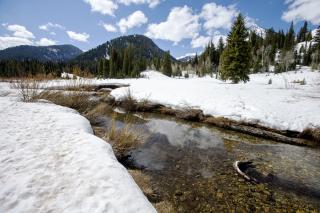December 1st Climate and Water Report for Utah

Current Valley Conditions (SCAN)
Unfortunately, the water year momentum gathered during October came to a screeching halt in November. With almost no precipitation accumulated in November, the water year total for Utah’s valley locations now stands at 2.2 inches. As is often the case, Northern Utah fared the best during the month. Although soil moisture levels decreased during the month, we are still above of last year’s levels at this time. Generally, soil temperatures are rising in response to the warm temperatures associated with the dominant high pressure. Drought conditions improved slightly during November; the percentage of Utah experiencing exceptional (D4) drought has dropped from 14% to 10% during the month. Let’s hope for a pattern change in December!
Current Mountain Conditions (SNOTEL)
Some of you may remember a weather phenomenon we used to receive in Utah called “snow”. It was a lovely substance and provided the vast majority of our water supply each year. It was also useful for sledding, skiing, photography, and pegging your younger sibling with snowballs. If you happen to know where our snow went, can you please get in touch?
In all seriousness, November’s precipitation in Utah was very disappointing and as a result our snowpack levels in Utah’s mountains are quite low. As of December 1st, the statewide snow water equivalent was only 32% of median, which is particularly disappointing after the outstanding start to our water year. November precipitation in Utah’s mountain locations was well below normal at 38%. Statewide soil moisture in Utah's mountains is still above average at 56% of saturation but has dropped significantly due to the warm, dry November. The soil moisture conditions vary regionally—whereas most watersheds in northern Utah continue to have fairly wet soils, several basins in southern Utah (especially Upper and Lower Sevier) are below average for this time of year.
Utah’s reservoir storage is currently at 49% of capacity, which is 13% lower than last year at this time, causing our Water Availability Indices (WAIs) to remain at alarmingly-low levels (bottom 20th percentile) for 10 of Utah’s 18 major basins. Our reservoir levels will not increase substantially until next spring when we receive the water stored in this winter’s snowpack, so water managers will need to continue to be diligent.

